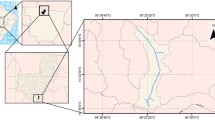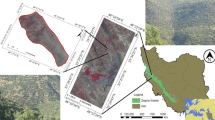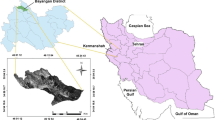Abstract
Understanding the relationship between the spatial distribution of forest vegetation and influencing factors provides valuable information to decision-makers in land planning, for the sustainable development of forests and efficient monitoring of environmental and ecological issues. This paper aims to understand the effect of topographic factors and lithology on forest cover distribution around Bin El Ouidane dam in the High Atlas Mountains of Morocco, using remote sensing, Geographical Information Systems (GIS), field observation, and statistical analysis. The forest vegetation was quantified by calculating the Normalized Vegetation Difference Index (NDVI) from Operational Land Imager (OLI) images. The NDVI was classified according to the density of forest vegetation into four levels: bare soil, low density of forest cover, moderate density of forest cover, and high density of forest cover. The correlation analysis between NDVI, interpreted as forest densities and topographic parameters (elevation, slope, and aspect), derived from the Digital Elevation Model (DEM), showed that elevation has the most significant positive correlation with forest density, with r = 0.563 and a p-value less than 0.05. Additionally, moderate and high densities of forest vegetation are optimal in the terrain aspect of the South-East and North-West, respectively. However, the NDVI variation cannot be interpreted only by altitude and terrain aspect. The Spectral Angle Mapper (SAM) classification has been used to map and to separate the forest vegetation types. The statistical results of the analysis of variance (ANOVA) showed that the altitude is the most important topographic factor affecting the distribution of forest species. The analysis of frequency histograms revealed that Holm oaks are increasing at high altitudes, and are more abundant in the North-West, while the Thuya species prefer moderate altitudes and are more abundant in the South-East-facing aspects. In our study area, the Holm oak develops on limestone formations. On the contrary, Thuya does not thrive in lithological conditions, and is found with a decreasing level of predominance on limestones, marls-limestones, and sandstones, respectively. The conclusion of the study shows that a combination of topographic factors and lithological conditions affects the spatial distribution of forest vegetation. The adaptation of the forest species to specific topography and lithological conditions should be considered for forest management. It can be helpful in selecting potential sites for reforestation of these species, for conservation of the natural resources, including water and soil.














Similar content being viewed by others
Availability of Data and Materials
All data generated and analyzed during this study are included in this article.
References
Maimouni, S., El-Harti, A., Bannari, A., & Bachaoui, M. (2012a). Water erosion risk mapping using derived parameters from DEM and remotely sensed data. Geo-spatial Information Science, 15(3), 157–169. https://doi.org/10.1080/10095020.2012.715855
Vásquez-Méndez, R., Ventura-Ramos, E., Oleschko, K., Hernández-Sandoval, L., Parrot, J. F., & Nearing, M. A. (2010). Soil erosion and runoff in different vegetation patches from semiarid Central Mexico. Catena, 80(3), 162–169. https://doi.org/10.1016/j.catena.2009.11.003
Kogo, B. K., Kumar, L., & Koech, R. (2019). Forest cover dynamics and underlying driving forces affecting ecosystem services in western Kenya. Remote Sensing Applications: Society and Environment, 14, 75–83. https://doi.org/10.1016/j.rsase.2019.02.007
Jin, X., Wan, L., Zhang, Y. K., Hu, G., Schaepman, M. E., Clevers, J. G. P. W., & Su, Z. B. (2009). Quantification of spatial distribution of vegetation in the Qilian Mountain area with MODIS NDVI. International Journal of Remote Sensing, 30(21), 5751–5766. https://doi.org/10.1080/01431160902736635
Zhang, Z., Zinda, J. A., Yang, Z., Yin, M., Ou, X., Xu, Q., &Yu, Q. (2018). Effects of topographic attributes on landscape pattern metrics based on redundancy ordination gradient analysis. Landscape and Ecological Engineering, 14(1), 67–77. https://doi.org/10.1007/s11355-016-0322-6
Mesev, V. (2007). Integration of GIS and Remote Sensing Florida. USA: Wiley, p.312
Zellweger, F., De Frenne, P., Lenoir, J., Rocchini, D., & Coomes, D. (2019). Advances in Microclimate Ecology Arising from Remote Sensing. Trends in Ecology & Evolution, 34 (4), 327-341, https://doi.org/10.1016/j.tree.2018.12.012
Zuo, X.A., Zhao, X.Y., Zhao, H.L., Zhang, T.H., Li, Y.L., Wang, S.K., Li, W.J., & Powers, R. (2012) Scale dependent effects of environmental factors on vegetation pattern and composition in Horqin Sandy Land, Northern China. Geoderma 173-174, 1-9. https://doi.org/10.1016/j.geoderma.2011.10.0032
Riihimäki, H., Heiskanen, J., & Luoto, M. (2017). The effect of topography on arctic-alpine aboveground biomass and NDVI patterns. International Journal of Applied Earth Observation and Geoinformation, 56, 44-53. https://doi.org/10.1016/j.jag.2016.11.005
Greiser, C., Meineri, E., Luoto, M., Ehrlén, J., & Hylander, K. (2018). Monthly microclimate models in a managed boreal forest landscape. Agricultural and Forest Meteorology, 250–251, 147-158. https://doi.org/10.1016/j.agrformet.2017.12.252
Huang, K.Y. (2002). Evaluation of the topographic sheltering effects on the spatial pattern of Taiwan fir using aerial photography and GIS. International Journal of Remote Sensing, 23(10), 2051-2069. https://doi.org/10.1080/01431160110076207
Lafon, C. W., Hanson, A. A., & Dwight, R. A. (2019). Geographic variations in fine-scale vegetation patterns: aspect preferences of montane pine stands over Southern Appalachian landscapes. Physical Geography , 40 (5), 433-460. https://doi.org/10.1080/02723646.2019.1576013
Busing, R. T., White, P. S., & McKenzie, M. D. (1993). Gradient analysis of old spruce-fir forest of the Great Smokey Mountains circa. Canadian Journal of Botany, 71(7), 951–958. https://doi.org/10.1139/b93-107
Zhan, Z. Z., Liu, H. B., Li, H. M., Wu, W., & Zhong, B. (2012). The relationship between NDVI and terrain factors—a case study of Chongqing. Procedia Environmental Sciences, 12, 765–771. https://doi.org/10.1016/j.proenv.2012.01.347
Wang, Y., Hou, X., Wang, M., Wu, L., Ying, L., & Feng, Y. (2013). Topographic controls on vegetation index in a hilly landscape: A case study in the Jiaodong Peninsula, eastern China. Environmental Earth Sciences, 70(2), 625–634. https://doi.org/10.1007/s12665-012-2146-5
Fu, B. J., Liu, S. L., Ma, K. M., & Zhu, Y. G. (2004). Relationships between soil characteristics, topography and plant diversity in a heterogeneous deciduous broad-leaved forest near Beijing. China. Plant Soil, 261(1–2), 47–54. https://doi.org/10.1023/B:PLSO.0000035567.97093.48
Ohwawa, T., Saito, Y., Sawada, H., & Ide, Y. (2008). Impact of altitude and topography on the genetic diversity of Quercus serrata populations in the Chichibu Mountains, central Japan. Flora, 203(3), 187–196. https://doi.org/10.1016/j.flora.2007.02.007
Zhang, Z., Hu, G., & Ni, J. (2013). Effects of topographical and edaphic factors on the distribution of plant communities in two subtropical karst forests, southwestern China. Journal of Mountain Science, 10(1), 95–104. https://doi.org/10.1007/s11629-013-2429-7
Zeng, X. H., Zhang, W. J., Song, Y. G., & Shen, H. T. (2014). Slope aspect and slope position have effects on plant diversity and spatial distribution in the hilly region of Mount Taihang, North China. Journal of Food Agriculture and Environment, 12(1), 391–397.
Oke, O. A., & Thompson, K. A. (2015). Distribution models for mountain plant species: The value of elevation. Ecological Modelling, 301, 72–77. https://doi.org/10.1016/j.ecolmodel.2015.01.019
Wang, B., Zhang, G., & Duan, J. (2015). Relationship between topography and the distribution of understory vegetation in a Pinus massoniana forest in Southern China. International Soil and Water Conservation Research, 3(4), 291–304. https://doi.org/10.1016/j.iswcr.2015.10.002
Cui, W., & Zheng, X. X. (2016). Spatial heterogeneity in tree diversity and forest structure of evergreen broadleaf forests in southern China along an altitudinal gradient. Forests, 7(10), 216. https://doi.org/10.3390/f7100216
Gokhale, B & Weber, K.T (2009). Spatial pattern of NDVI in semiarid ecosystems of northern Spain. Pages 149–156 in K.T. Weber and K. Davis (Eds.), Final Report: Comparing Effects of Management Practices on Rangeland Health with Geospatial Technologies (NNX06AE47G), p. 168.
Dai, S. P., Zhang, B., Wang, H. J., Wang, Y. M., Guo, L. X., Wang, X. M., & Li, D. (2011). Vegetation cover change and the driving factors over northwest China. Journal of Arid land, 3(1), 5–33. https://doi.org/10.3724/sp.j.1227.2011.00025
Zhu, W., Lv, A., & Jia, S. (2011). Spatial distribution of vegetation and the influencing factors in Qaidam Basin based on NDVI. Journal of Arid Land, 3(2), 85–93. https://doi.org/10.3724/SP.J.1227.2011.00085
Qiu, B., Zeng, C., Chen, C., Zhang, C., & Zhong, M. (2013). Vegetation distribution pattern along altitudinal gradient in subtropical mountainous and hilly river basin China. Journal of Geographical Sciences, 23(2), 247–257. https://doi.org/10.1007/s11442-013-1007-9
Zhang, H., Chi, T., Fan, J., Hu, K., & Peng, L. (2015). Spatial analysis of Wenchuan earthquake-damaged vegetation in the mountainous basins and its applications. Remote Sensing, 7(5), 5785–5804. https://doi.org/10.3390/rs70505785
Kayiranga, A., Ndayisaba, F., Nahayo, L., Karamage, F., Nsengiyumva, J. B., Mupenzi, C., & Nyesheja, E. M. (2017). Analysis of climate and topography impacts on the spatial distribution of vegetation in the Virunga Volcanoes massif of east-central Africa. Geosciences, 17(1), 1–18. https://doi.org/10.3390/geosciences7010017
Morley P.J. , Donoghue D.N.M., Chen J.C, Jump A.S. (2018) Integrating remote sensing and demography for more efficient and effective assessment of changing mountain forest distribution, Ecological Informatics, 43,106-115. https://doi.org/10.1016/j.ecoinf.2017.12.002
de Klerk, H. M., Burgess, N. D., & Visser, V. (2018). Probabilistic description of vegetation ecotones using remote sensing. Ecological Informatics, 46, 125–132. https://doi.org/10.1016/j.ecoinf.2018.06.001
Rouse, J.W., Haas, R.W., Schell, J.A., Deering, D.W., & Harlan, J.C. (1974) Monitoring the vernal advancement and retrogradation (Greenwave effect) of natural vegetation. NASA/GSFCT Type III Final Report, Greenbelt, MD, USA, p.164.
Buddenbaum, H., Schlerf, M., & Hill, J. (2005). Classification of coniferous tree species and age classes using hyperspectral data and geostatistical methods. International Journal of Remote Sensing, 26, 5453-5465. https://doi.org/10.1080/01431160500285076
Bahri, E., Haboudane, D., Bannari, A., Bonn, F., & Chillasse, L. (2007). Essai de cartographie des espèces forestières dominantes dans le Moyen Atlas (Maroc) à l’aide des données. Revue Télédétection, 7(1-2-3-4), 283-301.
Mohajane, M., Essahlaoui, A., Oudija, F., El Hafyani, M., & Cláudia Teodoro, A. (2017). Mapping forest species in the central middle atlas of Morocco (Azrou Forest) through remote sensing techniques. ISPRS International Journal of Geo-Information, 6(9), 275. https://doi.org/10.3390/ijgi6090275
DEF. (2019). Département des Eaux et Forêts http://www.eauxetforets.gov.ma/ForetsMarocaines/Formations/Pages/Formations-Forestieres.aspx
Khatouri, M. (1992). Growth and yield of young Quercus ilex coppice stands in the Tafferte forest (Morocco). Vegetatio, 99, 77-82. https://doi.org/10.1007/BF00118212
NASA (2018) https://landsat.gsfc.nasa.gov/landsat-data-continuity-mission/
Moore, I.D., Gessler, P.E., Nielson, G.A., & Peterson, G.A. (1993). Soil attribute prediction using terrain analysis. Soil Science Society of America Journal, 75, 443-452. https://doi.org/10.2136/sssaj1993.03615995005700020026x
Chavez, Jr., P.S., (1988). An improved dark-object subtraction technique for atmospheric scattering correction of multispectral data. Remote Sensing of Environment 24(3), 459–479. https://doi.org/10.1016/0034-4257(88)90019-3
El Harti, A. Lhissou, R., Chokmani, K., Ouzemou, J.E., Hassouna M., Bachaoui, E.M., & El Ghmari, A. (2016). Spatiotemporal monitoring of soil salinization in irrigated Tadla Plain (Morocco) using satellite spectral indices. The International Journal of Applied Earth Observation and Geoinformation, 50, 64-73. https://doi.org/10.1016/j.jag.2016.03.008
NASA (2000) https://earthobservatory.nasa.gov/features/MeasuringVegetation.
Kruse, F.A., Lefkoff, A.B., Boardman, J.W., Heidebrecht, K.B., Shapiro, P.J. & Goetz, A.F.H. (1993). The Spectral Image Processing System (SIPS)-Interactive Visualization and Analysis of Imaging Spectrometer Data. Remote Sensing of Environment, 44 (2-3), 145-163. https://doi.org/10.1016/0034-4257(93)90013-N
Lillesand, T.M., Kiefer, R.W., & Chipman, J.W. (2014). Remote Sensing and Image Interpretation; John Wiley & Sons: Hoboken, NJ, USA, p. 763, ISBN 9781118343289
Boardman, J.W., Kruse, F.A., & Green, R.O. (1995). Mapping target signatures via partial unmixing of AVIRIS data. Summaries of the Fifth JPL Airborne Earth Sciences Workshop, Pasadena (CA), USA, JPL Publication 95-1, 1, 23-26..
Plaza, A. & Chang, C. (2005). Fast implementation of pixel purity index algorithm. Algorithms and Technologies for Multispectral, Hyperspectral, and Ultraspectral Imagery XI, 28 March 2005, Orlando, FL, USA, vol. 5806, p. 307-317.
Hsueh, M. & Chang, C. (2008). Field Programmable Gate Arrays (FPGA) for Pixel Purity Index Using Blocks of Skewers for Endmember Extraction in Hyperspectral Imagery. The International Journal of High Performance Computing Applications, 22 (4), 408-423. https://doi.org/10.1177/1094342007088378
Gürsoy, Ö. & Kaya, Ş. (2017). Detecting of Lithological Units by Using Terrestrial Spectral Data and Remote Sensing Image. Journal of the Indian Society of Remote Sensing, 45, 259–269. https://doi.org/10.1007/s12524-016-0586-1
Margate, D.E. and Shrestha, D.P. (2001) The use of hyperspectral data in identifying ‘desert-like’ soil surface features in Tabernas area, southeast Spain. Proceedings of the 22nd Asian conference on remote sensing, 5-9 November 2001, Singapore CRISP, SISV, AARS. pp. 736-741
Maimouni, S., Bannari, A., El-Harti, A., & El-Ghmari, A. (2012b). Indices spectraux et “Spectral Angle Mapper” pour la cartographie des risques d’érosion hydrique à partir des données ALI EO-1. Revue Télédétection ,10 (4): 213- 223
Girouard, G., Bannari, A., El-Harti, A. and Desrochers, A. (2004). Validated Spectral Angle Mapper Algorithm for Geological Mapping: Comparative Study between Quickbird and Landsat-TM, Geo-Imagery Bridging Continents Istanbul, Turkey, July 12–23, p. 599–604.
Zhang, M., Qin, Z., Liu, X. & Ustin, S.L. (2003) Detection of stress in tomatoes induced by late blight disease in California, USA, using hyperspectral remote sensing. International Journal of Applied Earth Observation and Geoinformation, 4 (4), 295-310. https://doi.org/10.1016/S0303-2434(03)00008-4
Green, A.A., Berman, M., Switzer, P. & Craig, M.D. (1988). A transformation for ordering multispectral data in terms of image quality with implications for noise removal. IEEE Transactions on Geoscience and Remote Sensing, 26 (1), 65-74, https://doi.org/10.1109/36.3001
Congalton, R.G. (1991). A review assessing the accuracy of classifications of remotely sensed data. Remote Sensing of Environment, 37, 35-46. https://doi.org/10.1016/0034-4257(91)90048-B
Cohen, J. (1960) A coefficient of agreement for nominal scales. Educational and Psychological Measurement, 20, 37-46. https://doi.org/10.1177/001316446002000104
Bennie, J., Hill, M. O., Robert, B., & Brian, H. (2006). Influence of slope and aspect on long-term vegetation change in British chalk grasslands. Journal of Ecology, 94 (2), 355-368. https://doi.org/10.1111/j.1365-2745.2006.01104.x
Acknowledgements
We thank U.S. Geological Survey (USGS) for providing the Landsat OLI and ASTER images. As well, we gratefully acknowledge the anonymous referees for accepting to review the manuscript.
Author information
Authors and Affiliations
Contributions
All the authors participated in the elaboration of this article. Soufiane Maimouni developed the used methodology. The manuscript was written by Soufiane Maimouni, Lamia Daghor, and Rachid Lhissou. The obtained results were discussed in contribution with Mostafa Oukassou and Saida El Moutaki.
Corresponding author
Ethics declarations
Competing Interests
The authors declare no competing interests.
Additional information
Publisher's Note
Springer Nature remains neutral with regard to jurisdictional claims in published maps and institutional affiliations.
Rights and permissions
About this article
Cite this article
Maimouni, S., Daghor, L., Oukassou, M. et al. Evaluate the Effect of Topographic Factors and Lithology on Forest Cover Distribution: a Case Study of the Moroccan High Atlas. Environ Model Assess 26, 787–801 (2021). https://doi.org/10.1007/s10666-021-09785-3
Received:
Accepted:
Published:
Issue Date:
DOI: https://doi.org/10.1007/s10666-021-09785-3




